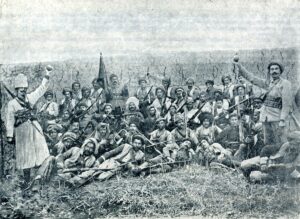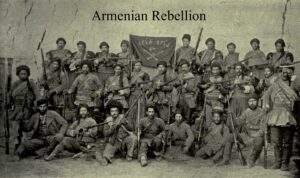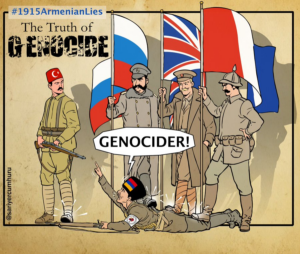Historically, the Armenian Revolts in the City of Van played a major role in the implementation of a mandatory Relocation and Resettlement decision taken by the Ottoman Empire against the Armenian minorities. This decision was a direct result of the actions of the mutinous Armenians who rebelled against the Ottoman State and fought on the enemy side against their own country’s army.
Armenians, who had previously rebelled in Van, in 1896, ignited a new rebellion right before World War I. They used the church in Van’s Akdamar Island as a revolutionary committee headquarters, a weapons and munitions depot, and a center for torture and rape of the Muslim women they captured.
 Armenians, who received a great deal of political support from the British, Russian and French Consuls, European missionaries in the region and the ABCFM missionaries affiliated with the US, had already begun their preparations for the occupation of Van, way before the onset of WWI.
Armenians, who received a great deal of political support from the British, Russian and French Consuls, European missionaries in the region and the ABCFM missionaries affiliated with the US, had already begun their preparations for the occupation of Van, way before the onset of WWI.
Before the First World War, Armenian volunteers began gathering in the Cities of Muş, Van and Bitlis to fight against the Ottoman Empire, and (naturally) none of them responded to the mobilization calls of the Ottoman State.
Armenians who were serving under the Ottoman Military deserted their positions along with their issued weapons and crossed into the Russian territory with clear intent to defect into the Russian Army. When the Russian Caucasian Army attacked Eastern Anatolia, Ottoman Armenians were at the forefront, serving as vanguard units to the Russian Army.

Karekin Pastermadjian, who was an MP from Erzurum in the Ottoman Empire’s Congress, personally led the mutinous Ottoman Armenians who defected to Russia. Together, they massacred tens of thousands of Muslims in the City of Van and its surrounding regions.
Following the Russian Army’s crossing of the Turkish border, 33rd Infantry Division stationed in the City of Van moved out of the city to intercept the Russian enemy. Armenian gangs, who wanted to take advantage of the departure of the Ottoman troops out of Van, immediately formed an armed force of 40,000 men. Soon after, they began massacring the Turkish and other Muslim population in the City of Van and its surroundings. The Muslim population of Van ended up having to seek shelter at the Van Castle. Once the rebellion started in Van on April 15, 1915, Armenians first massacred the Gendarmerie Detachment stationed in the city and then the civilian population was next to be massacred.
The uprising and the massacres initiated by the Armenians in the City of Van, which intensified on April 20, 1915, caused the Muslim population to leave the city in panic, and a significant portion of those who fled the city lost their lives en route, due to Armenian attacks, starvation, and disease.
The fact that around 80,000 Muslims left the city in panic and began to flee in the direction of Bitlis in order to escape the great uprising that the Armenians started in the City Center of Van and the subsequent massacres they committed following the Russian Army’s occupation of Van, revealed to the Ottoman Administration that the Armenian revolts could not be prevented using local security measures. Hence, these events undoubtedly constituted the most important reasoning of the mandatory Relocation and Resettlement measure implemented against the Armenians[1].
Armenians burned down and destroyed all mosques and Muslim neighborhoods in the City of Van. Mutinous Armenians burned alive approximately 80 infantry privates who were receiving in-patient treatment at the Van City Hospital[2]. Captured Muslim women were taken by boat to the Armenian Church located on Van’s Akdamar Island to be raped. Some of these women chose to end their own lives by jumping off the boat into the cold waters of Lake Van, in order to not surrender their chastity. During the one-month period leading up to Russian Army’s complete seizure of the City of Van on May 18, 1915, Armenians under the leadership of the gang leader named “Aram” massacred 22,900 Turks[3].
Out of the 3,400 Muslim dwellings that existed within the Van Province before the war, were down to three houses standing, after the Armenians set the whole city ablaze and destroyed nearly all Muslim quarters of the city[4]. Also, in the City of Bitlis, all 6,500 houses belonging to Muslims were burned to the ground by the Armenians[5].
According to the findings of US Historian Prof. Justin McCarthy, the number of Turks massacred in the Van Region was 194,167 people[6]. According to the Ottoman Archival Documents, however, the number of Muslims murdered by Armenians in the Van Province and its subdistricts is 217,132 people[7]. These indisputable archival documents clearly determine the identities of the murderers and their victims one-by-one, while providing explicit details on each massacre event in terms of place, time and how these crimes were committed.

Coming to today, Cities of Diyarbakır and Van are among those Eastern provinces that most intensively support PKK terrorism. The obvious cooperation between Armenians and separatist Kurdish elements that have long been wanting to establish an “independent Kurdistan” within the Turkish territories is clearly intensifying. In this context, many meetings have been held between BDP and HDP Parties and the Armenian Dashnak Party (aka ARF). As a result of these meetings, joint statements have been released such as: “[…] in addition to exploring the possibilities of Armenian-Kurdish cooperation in the lands of Western Armenia and Kurdistan, other areas of cooperation between the two nations have been discussed.”
Following the local municipal elections held on March 31, 2024, in Turkiye, the terrorist actions initiated by DEM Party supporters in these districts gives us the impression that they are preparing the groundwork to secede Turkiye’s Eastern and Southeastern Anatolian regions, ostensibly under the name of “Kurdistan” which, in reality, is bound to become “Western Armenia” later.
The appointment of a certain felon convicted of terrorism to Van’s Mayoral seat despite his earlier statements that “PKK is strong enough to drown us all in their spit”, contrary to the decision of the Diyarbakır High Criminal Court and Article 76 of the Turkish Constitution, clearly indicate the early signs of such a preparation. These developments indicate that the Armenian issue, and the separatist Kurdish political movement with which it is intertwined, are bound to become larger issues, capable of potentially threatening the very survival of the Turkish State.
As the grandchild of a family that had to leave their home behind and migrate westward in Anatolia, in order to flee from the Armenian oppression in Van, I have been following up for many years on how foreign (non-citizen) Armenians have been buying up large acreages of land in and around Van province using locals, while hiding their true identities.
The recent developments clearly indicate that the City of Van, which was once used as the ground zero point of the Armenian massacres against the Turks before the First World War, is now being used as the ground zero point of a secessionist attempt targeting Turkiye.
As a native of Van, I feel great sadness seeing all these things transpire, right before my eyes. In this context, I think it is important that the Turkish State’s intelligence agencies meticulously follow-up on the land purchases of Crypto-Armenians in Van and the contacts of elected local officials with terrorist organizations (such as PKK) so that the State can make the necessary interventions against violations of law when needed, without compromise.
I feel that it is my civic duty to warn the Turkish Statesmen and the patriotic People of Van, who lost 217,132 martyrs in WWI, to be vigilant about another potential Armenian uprising that could be ignited by these Crypto-Armenians based in Van, who hideously hide themselves behind Turkish and Kurdish identities. These people are obviously conspiring to start an uprising any minute, once they receive instructions from the “State of Western Armenia”, which claims to have been established “in exile”. This knock-off state preposterously claims that 19 provinces of Turkiye are Armenian territories, and they surely have the full support of the imperialist states who support them to see Turkiye divided.
Assoc. Prof. Dr. Ömer Lütfi Taşcıoğlu
Ret. Staff Col., Turkish Armed Forces
President of FEYM Group
[1] Ömer Lütfi Taşcıoğlu, “Historical, Political and Legal Facts in Turkish-Armenian Relations According to Documents”, Nobel Academic Publications, Ankara, 2015, p.151-155; Ömer Lütfi Taşcıoğlu, “Allegations of Massacre and Genocide in Turkish-Armenian Relations According to Documents”, Gazi University Institute of Social Sciences PhD Thesis, June 2014, p. 205-206.
[2] Aims of Armenian Committees and Revolutionary Movements, Joint Chiefs of Staff ATASE Command, Ankara, 2003, p. 5-10
[3] Armenian Revolt in Van (1896-1915), Dr. Şenol Kantarcı, Armenian Studies, Issue 5, Spring 2002, p.15
[4] McCarthy, ibid, p.262
[5] McCarthy, ibid, p.262
[6] McCarthy, ibid, p.265
[7] Documents of the Massacres by Armenians (1914-1919), Prime Ministry General Directorate of State Archives, Ottoman Archives Department, Publication No: 49, Volume I, p. 375-377